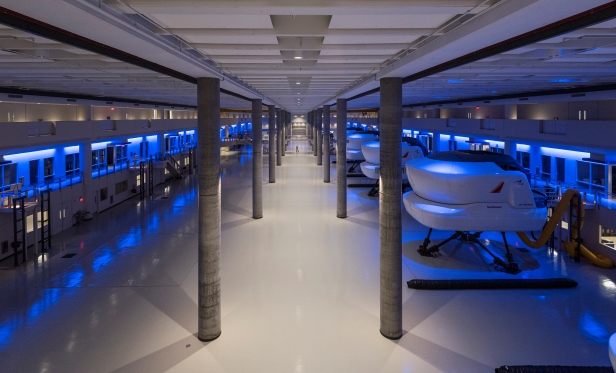
DALLAS—After a two-year span, McCarthy Building Companies Inc. recently completed the Southwest Airlines Wings project located adjacent to Love Field Airport, expanding Southwest's campus headquarters. The project consists of a new office building along with a Leadership Education and Aircrew Development/LEAD Center.
The complex includes a six-story 425,000-square-foot office building, a 1,950-space parking garage and an attached 375,000-square-foot LEAD building that houses 18 flight simulator bays. These flight simulators will be used to train pilots on existing and new aircraft added to Southwest's fleet. The simulators are installed on 24-inch slabs isolated from the rest of the building in order to provide the necessary support due to the high reactions generated by the machinery and avoid impact to the balance of the building's structural system.
McCarthy served as the construction manager at-risk with architect BOKA Powell on the Wings project, and the team faced some unique challenges along the way. The LEAD Center was designed and built to protect the expensive equipment it houses against natural and man-made disasters, and McCarthy had to determine the right materials to meet that need.
The LEAD Center is built with a pre-cast hardened structure designed to withstand the forces of an F3 tornado (or wind speeds of 210 mph). It also includes a blast slab, two-layer roof and a 20-by-20-foot elevator, which is the largest elevator ever built in a flight simulator facility. Additionally, the team added additional reinforcing and large columns to increase structural rigidity.
McCarthy utilized innovative technologies such as laser scanning during construction to maintain quality on the job site, and save time and money. Building information modeling was used to assist crews with precise installation of all structural components. Teams used a model for coordination of MEP for concrete lift drawings to ensure plates, electric panels and wires were not missed. These methods ultimately help the client track placement of all building elements for future repairs and renovations.
“At McCarthy, we have been steadily increasing our aviation sector portfolio and we are fortunate to have worked for an exceptional client like Southwest Airlines on an exciting and technically complex project,” Ray Sedey, McCarthy's southern region president, tells GlobeSt.com. “From Southwest Airlines and their employees, BOKA Powell architects and their engineering consultants, along with McCarthy and our trade partners, we all fostered an all-in team attitude.”
© Touchpoint Markets, All Rights Reserved. Request academic re-use from www.copyright.com. All other uses, submit a request to [email protected]. For more inforrmation visit Asset & Logo Licensing.







